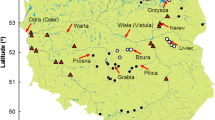Abstract
The proundal macrozoobenthos of 12 Finnish inland polyhumic reservoirs was studied by quantitative sampling in 1984 and 1986. Additionally, the succession of the macrozoobenthos in one young reservoir (Lake Kyrkösjärvi) was studied during its first six years. The zoobenthos material was analyzed using the DCA (detrended correspondence analysis) method, and the ordination of sites (i.e. reservoirs), was related to associated environmental data. The role of chironomids was, in general, important in the profundal of the reservoirs. Because of the coarse bottom quality at many sampling sites, many littoral taxa were found in the profundal zone. The genusChironomus dominated (>50% of the total zoobenthic biomass) especially in the acidic, upper-reach reservoirs.Chironomus larvae also dominated in the zoobenthos of Lake Kyrkösjärvi during its first three years. Some of the reservoirs showed similarities with the dystrophic lake type of the lake typology system (Brundin, 1956). Because of the initially eutrophic character of the bottom, many reservoirs belonged to eutrophic lake types. Finnish reservoirs appear to contain a zoobenthic fauna intermediate between natural lakes and bog pools. This theme was discussed from the ecological and evolutionary point of view ofChironomus species.
Similar content being viewed by others
References
BRUNDIN, L., 1956. Die bodenfaunistischen Seetypen und ihre Anwendbarkeit auf die Südhalbkugel. Zugleich eine Theorie der produktionsbiologischen Bedeutung der glazialen Erosion. Rep. Inst. Freshw. Res. Drottningholm, 37: 186–235.
HILL, M.O., 1979. DECORANA-A Fortran program for detrended, correspondence analysis and reciprocal averaging. Ecology and Systematics, Cornell University, Ithaca, New York.
JANKOVIC, M., 1974. Die Entwicklung der Bodenfauna in den Gebirgsstaubecken. Verh. Int. Ver. Limnol., 18: 813–817.
JOHNSON, R.K., 1985. Feeding efficiencies ofChironomus plumosus (L.) andC. anthracinus Zett. (Diptera: Chironomidae) in mesotrophic Lake Erken. Freshw. Biol., 15: 605–612.
KANSANEN, P.H., J. AHO and L. PAASIVIRTA, 1984. Testing the benthic lake type concept on chironomid associations in some Finnish lakes using multivariate statistical methods. Ann. Zool. Fenn., 21: 55–76.
KIKNADZE, I.I., 1987. Chromosomal polymorphism in natural populations of theplumosus species-group of West Siberia (Diptera: Chironomidae). Ent. Scand. Suppl., 29: 113–121.
KOSKENNIEMI, E. and L. PAASIVIRTA, 1987. The chironomid (Diptera) fauna in a Finnish reservoir during its first four years. Ent. Scand. Suppl., 29: 239–246.
KOSKENNIEMI, E., E.K. RANTA, R. PALOMÄKI and P. SEVOLA, 1990. On the natural and introduced fish fauna in Finnish inland reservoirs. In: W.L.T. van Densen, B. Steinmetz and R.H. Hughes eds., Management of freshwater fisheries. Proceedings of a symposium organized by the European Inland Fisheries Advisory Commission, Göteborg, Sweden, 31 May–3 June 1988. Pudoc. Wageningen. pp. 74–81.
P.H. LANGTON, 1991. A key to pupal exuviae of West Palaearctic Chironomidae. 386 pp. Huntingdon, Cambridgeshire, England. Privately published.
LINDEBERG, B. and T. WIEDERHOLM, 1979. Notes on the taxonomy of European species ofChironomus (Diptera, Chironomidae). Ent. Scand. Suppl., 10: 99–116.
McLACHLAN, A.J. and S.M. McLACHLAN, 1975. The physical environment and bottom fauna of a bog lake. Arch. Hydrobiol., 76: 198–217.
McLACHLAN, A.J. and M.A. CANTRELL, 1976. Sediment development and its influence on the distribution and tube structure ofChironomus plumosus L. (Chironomidae, Diptera) in a new impoundment. Freshw. Biol., 6: 437–443.
MERILÄINEN, J.J. and J. HYNYNEN, 1990. Benthic invertebrates in relation to acidity in Finnish forest lakes. In: L. Kauppl, P. Anttila, and Kenttämies, K., eds., Acidification in Finland: 1029–1049. Springer-Verlag, Berlin and Heidelberg.
MILBRINK, G., 1978. Indicator communities of oligochaetes in Scandinavian lakes. Verh. Int. Ver. Limnol., 20: 2406–2411.
ORMEROD, S.J. and R.W. EDWARDS, 1987. The ordination and classification of macroinvertebrate assemblages in the catchment of the River Wye in relation to environmental factors. Freshw. Biol., 17: 533–546.
PAASIVIRTA, L., 1983. Chironomidae and Chaoboridae (Diptera) of small forest lakes in Central Finland. Acta. Ent. Fenn., 42: 57–63.
PAASIVIRTA, L. and E. KOSKENNIEMI, 1980. The Chironomidae (Diptera) in two polyhumic reservoirs in western Finland. In: D.A. Murray, ed., Chironomidae: Ecology, systematics, cytology and physiology: 233–238. Oxford and New York.
PLIGIN, Yu.V. and L.A. ZHURAVLEVA, 1982. Applicability of certain common bioindication methods to evaluation of water quality in the littoral zone of the Kremenchug reservoir. Hydrobiol. J., 2: 30–34.
PRAT, N., 1980. Bentos de los embalses espanoles. Oecol. aquat., 4: 3–43.
ROSENBERG, D.M., B. BILYJ and A.P. WIENS, 1984. Chironomidae (Diptera) emerging from the littoral zone of reservoirs, with special reference to Southern Indian Lake, Manitoba. Can. J. Fish. Aquat. Sci., 41: 672–681.
SÆTHER, O.A., 1975. Nearctic chironomids as indicators of lake typology. Verh. Int. Ver. Limnol., 19: 3127–3133.
SÆTHER, O.A., 1979. Chironomid communities as water quality indicators. Holarct. Ecol., 2: 65–74.
SOKAL, R.R., and F.J. ROHLF, 1981. Biometry. Freeman, San Francisco.
WIEDERHOLM, T., 1980. The use of benthos in lake monitoring. J. Wat. Poll. Control Fed., 52: 537–547.
WÜLKER, W., 1991a.Chironomus fratemus n.sp. andC. beljaninae n.sp., sympatric sister species of theaberratus-group in Fennoscandian reservoirs. Ent. Fenn., 2: 97–109.
WÜLKER, W., 1991b. Chromosomal, morphological and biological differences betweenChironomus tenuistylus Brudin andC. longistylus Goetghebuer (Diptera: Chironomidae) in Fennoscandia and the USA. Ent. Scand., 22: 231–240.
Author information
Authors and Affiliations
Rights and permissions
About this article
Cite this article
Koskenniemi, E. The role of chironomids (Diptera) in the profundal macrozoobenthos in Finnish reservoirs. Netherlands Journal of Aquatic Ecology 26, 503–508 (1992). https://doi.org/10.1007/BF02255282
Issue Date:
DOI: https://doi.org/10.1007/BF02255282




